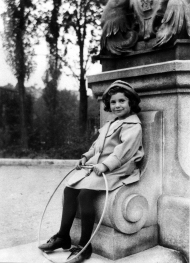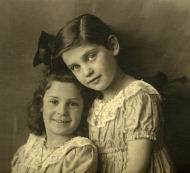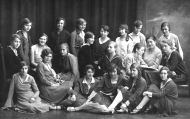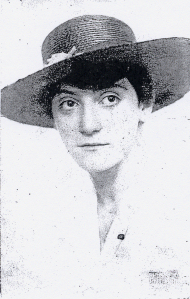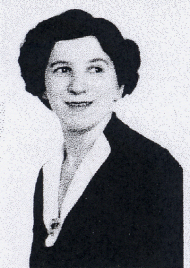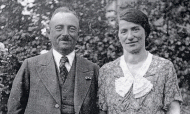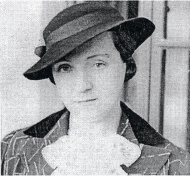|
|
|
|
|
|
|
|
|
|
|
|
|
|
|
|
|
|
|
|
|
|
|
|
|
|
|
|
|
|
|
|
|
|
|
|
|
|
|
|
|
|
|
|
|
|
|
|
|
|
|
|
|
|
|
|
|
|
|
|
|
|
|
||||||||||||||||||||||||||||||||||||||||||||||||||||||||||||||||||||||||||||||||||||||||||||||||||||||||||||||||
|
|
Elisabeth Oberdorfer Born: 1910 in Augsburg. Father’s occupation: factory owner (umbrella manufacturer). Flat: 15 / III Schaezlerstraße. Business: 19 Maximilianstraße. Elisabeth’s father, Eugen Oberdorfer (b. 1875 in Augsburg), ran an umbrella business. In World War I he fought as a “Landsturmjäger”. His wife was called Emma Karolina, née Binswanger (b. 1884 in Augsburg). Like Elisabeth, her elder sister Marianne also attended Maria-Theresia-School. Elisabeth attended Maria-Theresia-School from 1924 to 1926 in classes 5a and 6a; presumably, she had joined the school in class 1 in 1920. In May 1925, Elisabeth celebrated her “confirmation” in Augsburg, together with nine other Jewish girls (Bat Mitzvah: the feast of religious maturity for Jewish girls; it can be celebrated individually on the Sabbath after a girl’s 12th birthday, but in Augsburg it was held annually or after even longer intervals for several age groups together, similar to the Protestant confirmation). Elisabeth went to Rome in 1934 because she wanted to learn the Italian language and train tickets were cheap during the “Holy Year”. She worked au pair and in an antiquarian bookshop. In 1938, when still living in Rome, she married Friedrich G. Friedmann (b. 1912 in Augsburg), whose father was a joint owner of the linen manufacturing company “Friedmann & Dannenbaum” in Augsburg. Friedrich (“Fritz”) had attended the secondary school (“Gymnasium”) “St. Stephan” until 1931. In 1933, he was briefly arrested by the Gestapo and soon thereafter fled to Rome. He worked as a Latin teacher in the Vatican and studied philosophy at the university. In 1939, the married couple fled from Italy to England. In London, their son, John Friedman, was born in 1940. Fom there, the family emigrated under dramatic circumstances by ship’s convoy to the USA (only one ship arrived, all the others were torpedoed near Canada by German submarines). |
Eugen and Emma Karolina Oberdorfer, Elisabeth’s parents, had to move to 14 Hallstraße in May 1942. The National Socialists established a “Jewish house” (“Judenhaus”) at that place. From Summer 1942 to the beginning of March 1943, the couple had to do forced labor at Augsburg’s balloon factory. Then they were deported, presumably on March 8/9, to Auschwitz (perhaps via Terezin); they are considered missing. In the USA, Fritz Friedmann had an academic career. Elisabeth devoted herself totally to her family. Although she had no chance to study, she was well educated and edited many texts written by her husband before they were published. In 1960, Elisabeth and her husband returned to Germany. First they lived in Munich. From 1960 to 1979, Fritz was a professor for Northern American Cultural History and Director of the “Amerika-Institut” of Ludwig-Maximilians-University of Munich. He retired in 1979. Later, the couple moved to Friedberg (near Augsburg). Elisabeth Friedmann, née Oberdorfer, died in Friedberg in 2002. She was buried in the Jewish cemetery, Augsburg, Haunstetter Straße. She had been part of Augsburg’s German liberal Jewish community; however, there were less than ten adult Jewish men left of that community, so kaddish could not be said at Elisabeth’s grave (kaddish: a Jewish prayer in praise of God’s name; a version of it is to be said by the son or daughter of the deceased at the cemetery, in attendance of at least ten adult men). Elisabeth’s husband, Fritz Friedmann, died in January 2008. |
Elisabeth’s daughter, Miriam Friedmann (b. 1942 in Jackson, Tennessee), lived for a long time in New York. She was substantially involved in publications about Hertha Nathorff, a cousin of Albert Einstein (Das Tagebuch der Hertha Nathorff. Berlin—New York, Aufzeichnungen 1933 bis 1945, ed. Wolfgang Benz, Munich, 1987; film Traumspuren, HFF München and Bayerischer Rundfunk, 1993, dir. Patrick Hörl). She contributed much information to the “Spurensuche” project. (Anna Friedmann was Miriam Friedmann’s paternal aunt.) (This brief biography is based on information from Elisabeth’s daughter, Miriam Friedmann.) Aside: Eugen and Emma Karolina Oberdorfer are said to have been deported at an unknown time with unknown destination in the Gedenkbuch edited by the “Bundesarchiv” (2nd edition, 2006). They are not listed in the Theresienstädter Gedenkbuch, Prague, 2000. |
|
|
Marianne Oberdorfer Born: 1907 in Augsburg. Father’s occupation: factory owner (umbrella manufacturer). Flat: 15 / III Schaezlerstraße. Business: 19 Maximilianstraße. Marianne’s father, Eugen Oberdorfer (b. 1875 in Augsburg), ran an umbrella business. In World War I he fought as a “Landsturmjäger”. His wife was called Emma Karolina, née Binswanger (b. 1884 in Augsburg). Like Marianne, her sister Elisabeth also attended Maria-Theresia-School. Marianne attended Maria-Theresia-School from 1918 to 1925, first in classes 2–6, finally for two years to prepare herself for the educator’s exam. In 1921, Marianne celebrated her “confirmation” in Augsburg, together with six other Jewish girls (Bat Mitzvah: the feast of religious maturity for Jewish girls; it can be celebrated individually after the girl’s 12th birthday, but in Augsburg it was held annually or after even longer intervals for several age groups together, similar to the Protestant confirmation). Marianne became a qualified X-Ray Assistant. In 1936, she married Robert Weil (b. 1904 in Munich). In 1938, the couple emigrated to the USA, while Marianne’s sister, Elisabeth, was still living in Rome. Elisabeth and Robert first lived in Houston, Texas, then transferred to Los Angeles. Having worked as an assistant at a baker’s for some time, Marianne found a job at an orphanage. Robert was a representative for textiles. The couple had a son. Marianne Weil, née Oberdorfer, died in Los Angeles in 2001. Eugen and Emma Karolina Oberdorfer, Marianne’s parents, had to move to 14 Hallstraße in May 1942. The National Socialists established a “Jewish house” (“Judenhaus”) at that place. From summer 1942 to the beginning of March 1943, the couple had to do forced labor at Augsburg’s balloon factory. T hen they were deported, presumably on March 8/9, to Auschwitz (perhaps via Terezin); they are considered missing. |
(Marianne’s niece, Miriam Friedmann, provided much information for this brief biography.) Aside: Eugen and Emma Karolina Oberdorfer are said to have been deported at an unknown time with unknown destination in the Gedenkbuch edited by the “Bundesarchiv” (2nd edition, 2006). They are not listed in the Theresienstädter Gedenkbuch, Prague, 2000. |
|
Lisbeth Obermayer Born: 1914 in Augsburg. Father’s occupation: businessman. Lisbeth attended Maria-Theresia-School from 1924 to 1930 in classes 1–6. In 1934, Lisbeth married the businessman Erich Schwarz (b. 1906 in Augsburg), the brother of Ilse Schwarz. A daughter was born to them in 1936. In 1937, the family emigrated to the USA. In New York City, Erich ran a soap factory. Later the family moved to Kew Gardens, New York. Lisbeth Schwarz, née Obermayer, died in New York in 2004. |
|
|
Adele Obernbreit Born: 1898 in Augsburg. Father’s occupation: businessman. Adele’s father, Emanuel Obernbreit (b. 1866), was the owner of a shoe shop. His wife was Cäcilie (Cäzilia), née Großmann (b. 1862). Like Adele, her sisters Elsa, Ernestine and Rosa also attended the “Municipal School for Daughters” (“Städti-sche Töchterschule”), which from 1914 on was called “Maria-Theresia-School”. Adele attended the “Töchterschule” from 1909 to 1912 in classes 1b, 3b and 4a. At the end of 1922, Adele married Samuel Obarzanek (or “Oberschaneck”, b. 1896 in Warta, Poland), who worked as a dressmaker in Munich. The couple had two children, Thea (b. 1923) and Emanuel (b. 1927). The family lived at 22 Corneliusstraße, Munich, where Samuel also ran his workshop. Adele’s father, Emanuel Obernbreit, died in Augsburg in 1924. In 1929, the widowed Cäcilie and her youngest daughter, Elsa, moved to Munich. They lived in a house next to the Reichenbachstraße Synagogue and not far from the apartment of the Obarzanek family. In 1938, the German government began to harass especially those Jews who were Polish citizens but lived in Germany. Samuel Obarzanek was allowed to continue working for Jewish customers until Summer 1939; then he was expelled. The only country that opened its borders for him and his family was Italy. The family settled in Milan. Adele worked as a seamstress, Samuel continued working as a dressmaker, Thea had to work as a housemaid. In the beginning of July 1940, the Obarzanek family, like many other foreign Jews, was interned by the Italian government in Calabria. Samuel was sent to the internment camp Ferramonti, the others first had to go to the village Rogliano, after several weeks, however, they joined Samuel in Ferramonti. The guards treated them well, and they had enough food. Ferramonti was located in a swampy region, so they were given quinine to protect them from malaria. |
In the camp, Adele and Samuel took a boy with them, Harry (Enrich, Heinrich), who had no family there. In October 1941, having been interned in the South for sixteen months, the Obarzanek family was sent to Northern Italy again. In Villanova d’Asti, Adele and Samuel took up their usual occupations, Thea did the housekeeping. In the fall of 1943, the family was informed by their landlady that Germans had begun arresting Jews in the south of Italy. The family hided in Zimone, a mountain village in Piemonte. They were accomodated in a barn; the townspeople supported them. However, due to the carelessness of the boy they had brought along from Ferramonti, some day the whole family was discovered and arrested by Italian soldiers. They were sent to a prison in Turin that was under German command (presumably, it was the prison called “Le Nuove”). In the year 2000, a friend from Zimone still remembered the family being taken off with their palliasses on a cart. According to Liliana Picciotto’s Libro della memoria (“Memorial Book”, third edition, 2002), that misfortune occurred in June 1944. From the prison in Torino the family was sent to a transit camp. They stayed there for a very short while and from there were transported to Auschwitz. Around 50–55 persons were packed into each cattle car of the train. The journey took five days. According to the Libro della memoria, the train left Verona on August 2nd and arrived at Auschwitz on August 6, 1944. It is not known what happened to Harry, the unfortunate boy whom the Obarzanek family had brought from Ferramonti. He seems not to have been among the people who were deported from Italy to Auschwitz in August 1944. Samuel Obarzanek was killed in Auschwitz shortly after his arrival. The 17-year-old Emanuel was sent to the auxiliary camp Auschwitz-Charlottengrube (in |
Rydultau) in order to do forced labor in coal mines. There he got an infection on his leg and was sent back to Auschwitz to be killed. Adele and Thea, however, survived. They were sent from Auschwitz to Liebau (Lubawka), to a division of the Groß-Rosen concentration camp in Lower Silesia. (Towards the end of the war, thousands of concentration camp inmates were assembled in Groß-Rosen and its auxiliary camps.) Adele and Thea were liberated in Liebau by Russian troops: “On May 8, 1945, the German guards had left Liebau, we assumed over night. A few hours later Russian troops came and told us that the Germans had surrendered in Germany.” (Thea Aschkenase, née Obarzanek, e-mail from May 8, 2007.) Adele’s mother, Cäcilie, returned from Munich to Augsburg in 1939 and lived at 1 Brunhildenstraße. On July 31, 1942, she was deported, via Munich, to Terezin, where she died of typhoid on January 30, 1943. That’s what Adele and Thea learned when they came to Terezin after their liberation. Adele and Thea emigrated first to Palestine (Tel Aviv), then to the USA. Adele (“Ada”) Obarzanek, née Obernbreit, died in Worcester, Massachusetts, in 1974. (This brief biography is based on information provided by Thea Aschkenase, Ada Obarzanek’s daughter, via e-mails in January–May 2007.) Aside: In the Libro della memoria (edition of 2002) it is said that the Obarzanek family was sent from the prison in Turin to a prison in Milan, but according to Thea Aschkenase, née Obarzanek, that information is wrong. |
|
|
Elsa Obernbreit Born: 1903 in Augsburg. Father’s occupation: businessman. Elsa’s father, Emanuel Obernbreit (b. 1866), was the owner of a shoe shop. His wife was Cäcilie (Cäzilia), née Großmann (b. 1862). Like Elsa, her elder sisters Adele, Ernestine and Rosa also had attended the “Municipal School for Daughters” (“Städtische Töchterschule”), whose designation was changed to “Municipal Secondary School for Girls” (“Städtische Höhere Töchterschule”) in 1912 and which from 1914 on was called “Maria-Theresia-School”. Elsa joined the school in class 1 in 1913. In 1916/17, she had to repeat the third year; perhaps she completed the fourth grade in 1917/18. Emanuel Obernbreit, Elsa’s father, died in Augsburg in 1924. In 1922, her sister Adele had married the dressmaker Samuel Obarzanek; since then, she lived with her husband in Munich. In 1929, Elsa and her mother, the widowed Cäcilie, also moved from Augsburg to Munich. Their apartment was located in Reichenbachstraße, near to one of Munich’s three synagogues and not far from the apartment of Adele and her family. Samuel Obarzanek was a Jew of Polish origin. In 1939, he was expelled from Germany. He and his family were able to settle in Italy (in 1944, however, they were deported to Auschwitz). Elsa succeeded in fleeing National Socialism and transferred to England, where she could work as a housemaid. Elsa’s mother, Cäcilie, returned from Munich to Augsburg and lived at 1 Brunhildenstraße. On July 31, 1942, she was deported, via Munich, to Terezin, where she died of typhoid on January 30, 1943. Several years after World War II, Elsa emigrated from England to the USA. Her sister Adele, who had survived imprisonment in the Auschwitz and Liebau concentration camps, first had emigrated to Palestine after the war, together with her daughter, Thea. Now the two sisters lived near to each other, first in New |
York, then in Worcester, Massachusetts. Elsa was married; her married name was Weil. Elsa Weil, née Obernbreit, died in Worcester, Massachusetts, in 1992. (This brief biography is based on information provided by Thea Aschkenase, Elsa Weil’s niece, via e-mails in January and February 2007.) Source: Andreas Heusler, Brigitte Schmidt, Eva Ohlen, Tobias Weger, and Simone Dicke, with the collaboration of Maximilian Strnad, Biographisches Gedenkbuch der Münchner Juden 1933–1945, vol. 2 (M–Z), ed. Munich City Archives (“Stadtarchiv München”), Munich, 2007, pp. 201–2 and 207–8 (on the Obarzanek family and Cäcilie Obernbreit). |
|
|
Ernestine Obernbreit Born: 1895 in Augsburg. Father’s occupation: businessman. Ernestine’s father, Emanuel Obernbreit (b. 1866), was the owner of a shoe shop. His wife was Cäcilie (Cäzilia), née Großmann (b. 1862). Like Ernestine, her sisters Adele, Elsa and Rosa also attended the “Municipal School for Girls” (“Städtische Töchterschule”), which from 1914 on was called “Maria-Theresia-School”. Ernestine attended the “Töchterschule” from 1906 to 1909 in classes 1–3. In 1919, Ernestine married the cattle dealer Jacob Gruber (b. 1881). Jacob was an uncle of Berta Horn and Ilse Marx. Ilse described Ernestine’s wedding in a brief article in 2001. The couple had two sons. One of them, Paul (geb. 1920), emigrated to the USA at age 16. The other, Kurt (b. 1923), was deported, together with his parents, to Piaski, Poland, at the beginning of April 1942; all three are considered missing. For two months, from April to June 1942, the engineer Arnold Hindls from Brno, Moravia, also lived in Piaski. For him this was but one of many deportation stations, between Terezin and Ossovo. In his memoirs, One Man Returned, published in Germany in 1965, he tells about Piaski: “Piaski is a small town in the Lublin district, surrounded by sand, swamps, and forests. The state road from Lublin to Chelm divides it into two parts. Therefore, the Jewish ghetto, which once was very large and inhabited by approx. 3000 local Jews, extended on both sides of the state road. Now, however, these two parts of the ghetto were each enclosed by high fences made of boards and barbed wire. They had big gates, which were permanently guarded and opened only twice a day, for one hour in the morning and one in the afternoon. The gates were closed towards the state road. ... The houses of the ghetto were mostly made of wood. They had only small yards and were closely boxed together, mostly built on ground level, only a few had one story. ...The small town had neither plumbing nor sewer. For the approx. 6000 |
inhabitants of the two parts of the ghetto...there was only one well with acceptable drinking water in the southern part. Each person was allowed to fetch only one ten litre bucket a day from that well. ... The SS commando which was in charge of the ghetto was stationed in a large, solid building on the outskirts of the southern part of the ghetto, at the state road. The SS could well observe both parts of the ghetto from the balcony of the building. Every visit by those ‘members of the master race’ meant slaps, kicks, and beatings. They confiscated food which was ‘not allowed’ and smuggled into the ghetto. ...Twenty to thirty people, nothing but skin and bones, died of hunger every day. ... In spite of these catastrophic provision conditions, all men and women who were able to work were recruited into groups to do excavation, gardening, and upkeep of the roads. ...Also within the ghetto, there was enough work to do, for instance, the cleaning and deepening of the drainage and gravel ditches, and the construction of latrines, latrines, and more latrines, of which there were never enough.” In the autumn of 1942, some Jews were taken from Piaski to Belzec, the others, approx. 4000, were taken to Sobibor, where they were killed. Immediately thereafter, the Piaski ghetto was occupied anew by other deported Jews. – Emanuel Obernbreit, Ernestine’s father, died in Augsburg in 1924. In 1922, her sister Adele had married the dressmaker Samuel Obarzanek; since then, she lived with her husband in Munich. In 1929, Ernestine’s mother, the widowed Cäcilie, also moved from Augsburg to Munich, together with her youngest daughter, Elsa. Samuel Obarzanek was a Jew of Polish origin. In 1939, he was expelled from Germany. He and his family were able to settle in Italy (in 1944, however, they |
were deported to Auschwitz). Elsa succeeded in fleeing National Socialism and transferred to England. Ernestine’s mother, Cäcilie, returned from Munich to Augsburg and lived at 1 Brunhildenstraße. On July 31, 1942, she was deported, via Munich, to Terezin, where she died of typhoid on January 30, 1943. Ernestine’s older son, Paul Gruber, joined the US Army during World War II. Afterwards, he became a communications technologist. He died in 2003. Ernestine Gruber’s name is listed on a glass plaque of the shoah memorial that can be visited in Augsburg’s City Hall (artist: Klaus Goth). Sources and further reading: Jean Mar (Ilse Marx), “Summer Wedding,” Kittay News, August 2001; also on this website (see below). Andreas Heusler, Brigitte Schmidt, Eva Ohlen, Tobias Weger, and Simone Dicke, with the collaboration of Maximilian Strnad, Biographisches Gedenkbuch der Münchner Juden 1933–1945, vol. 2 (M–Z), ed. Munich City Archives (“Stadtarchiv München”), Munich, 2007, pp. 201–2 and 207–8 (on the Obarzanek family and Cäcilie Obernbreit). Arnold Hindls, Einer kehrte zurück. Bericht eines Deportierten, Stuttgart, 1965, pp. 12–32. Letters and memories: Jean Mar, “Summer Wedding,” 2001. |
|
Rosa Obernbreit Born: 1892 in Augsburg. Father’s occupation: businessman. Rosa’s father, Emanuel Obernbreit (b. 1866), was the owner of a shoe shop. His wife was Cäcilie (Cäzilia), née Großmann (b. 1862). Like Rosa, her sisters Adele, Elsa and Ernestine also attended the “Municipal School for Girls” (“Städtische Töchterschule”), which from 1914 on was called “Maria-Theresia-School”. Rosa attended the “Töchterschule” from 1903 to 1906 in classes 1–3. In 1913, Rosa married the accountant Maurus Hajdu (Haydo) from Pressburg (Bratislava). The couple had a son, Pali, who emigrated to Palestine before the war. Emanuel Obernbreit, Rosa’s father, died in Augsburg in 1924. In 1922, her sister Adele had married the dressmaker Samuel Obarzanek; since then, Adele lived with her husband in Munich. In 1929, Rosa’s mother, the widowed Cäcilie, also moved from Augsburg to Munich, together with her youngest daughter, Elsa. Samuel Obarzanek was a Jew of Polish origin. In 1939, he was expelled from Germany. He and his family were able to settle in Italy (in 1944, however, they were deported to Auschwitz). Elsa succeeded in fleeing National Socialism and transferred to England. Rosa’s mother, Cäcilie, returned from Munich to Augsburg and lived at 1 Brunhildenstraße. On July 31, 1942, she was deported, via Munich, to Terezin, where she died of typhoid on January 30, 1943. According to her niece Thea Aschkenase, née Obarzanek, Rosa also was deported; further details are not known to date (e-mail from February 3, 2007). |
Source: Andreas Heusler, Brigitte Schmidt, Eva Ohlen, Tobias Weger, and Simone Dicke, with the collaboration of Maximilian Strnad, Biographisches Gedenkbuch der Münchner Juden 1933–1945, vol. 2 (M–Z), ed. Munich City Archives (“Stadtarchiv München”), Munich, 2007, pp. 201–2 and 207–8 (on the Obarzanek family and Cäcilie Obernbreit). |
